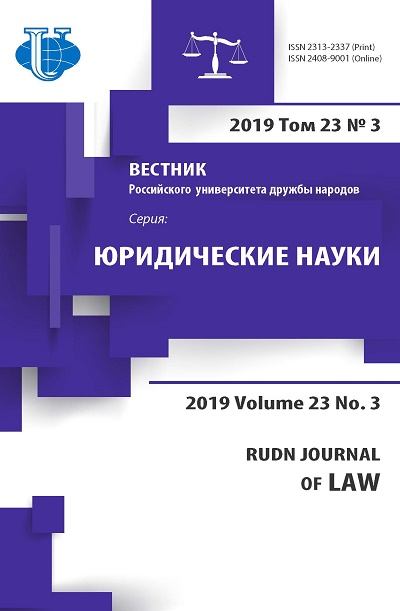INCREMENTAL TAX CREDIT FOR R&D (LEGISLATIVE PROPOSALS)
- Authors: Diumina V.E.1
-
Affiliations:
- Lomonosov Moscow State University
- Issue: Vol 23, No 3 (2019)
- Pages: 429-447
- Section: STATE AND LAW IN CONTEMPORARY WORLD
- URL: https://journals.rudn.ru/law/article/view/22371
- DOI: https://doi.org/10.22363/2313-2337-2019-23-3-429-447
- ID: 22371
Cite item
Full Text
Abstract
In conditions of limited resources, the government is looking for the most effective way of supporting and innovative development of priority sectors of the economy. Despite the fact that the question of the correlation between direct and indirect methods of stimulating investment and innovation activity remains open, more and more economically developed countries make a choice in favor of tax incentives and preferences. The need of finding the effective mechanisms of stimulating R&D in order to develop knowledge-intensive industries, creation of favorable conditions for innovation activity in the country - all of these confirm the importance of additional restructuring of the taxation system of the innovation sector of the economy. The most common form of tax incentives for innovation activity is tax credit. Based on the analysis of a wide range of foreign studies on the effectiveness of applying a tax credit for stimulating innovation activity, the article discusses and systematizes the positive and negative aspects of applying incremental and volume tax credits for R&D. In the study were used the method of comparative analysis to confront the experience of using different types of tax credit in different countries, the methods of cause-effect and system analysis to identify the main positive and negative aspects of applying volume and incremental tax credits. Based on dialectical method of knowledge, the directions of improving the mechanism of incremental tax credit were formulated. As the result of the analysis the assessment of applying the incremental tax credit for R&D in the existing tax system of Russian Federation and the recommendations for its transformation for increasing the effectiveness are given.
About the authors
Veronika E. Diumina
Lomonosov Moscow State University
Author for correspondence.
Email: khodosveronika@gmail.com
PhD-student, Faculty of Economics
1, bld. 13, Leninskie gory, 119234, Moscow, RussiaReferences
- Ermakova, E.A. (2015) Tax credits in the system of innovative activity stimulation. Upravlenets. [Manager]. (2), 4–10. (in Russian).
- Kuklina, E.A. (2014) The system of tax incentives and their effectiveness (in the context of innovative development of Russian Federation]. Vestnik Leningradskogo gosudarstvennogo universiteta im. A.S. Pushkina [Vestnik of Pushkin Leningrad State University]. 3 (6), 118–128. (in Russian).
- Koroleva, L.P., Kandrashkina? M.A. (2015) Tax credit as tool for stimulating R&D: foreign and domestic experience. Finance and Credit. 30 (21), 29–39. (in Russian).
- Melnikova, I.N. (2010) Stimulation of Scientific and Innovation Activity: Global Experience.
- Journal of International Law and International Relations. (3), 89–93. (in Russian). Мельникова И.Н. Стимулирование научно-инновационной деятельности: мировой опыт // Журнал международного права и международных отношений. 2010. № 3. С. 89–93.
- Ponomareva, N.V., Golubgtsova, E.V., (2015) Innovation activities: benefits from the Government. Nalogovyy uchet dlya bukhgaltera [Tax Accounting for Accountants]. (9), 49–54. (in Russian).
- Samarskii, M.A., Sorokina, L. (2011) Optimization of taxation as a tool for the development of innovation processes. Financial Journal. 2 (8), 133–140. (in Russian).
- Shmakova, M.N. (2007) On the issue of assessing the effectiveness of tax preferences. Nalogi i nalogooblozhenie [Taxes and Taxation]. (4), 57–62. (in Russian).
- Bronwyn, H. (2011) Effectiveness of the California R&D Tax Credit, University of California. Berkeley.
- Eisner, R., Albert, S. (1984) The new incremental tax credit for R&D: incentive or disincentive?National Tax Journal. 37 (2), 76–88. (in Russian).
- Guinet, J., Kamata, H. (1996) Do tax incentive promote innovations? The OECD Observer. (202). Invest in Holland. URL: https://www.oecd-ilibrary.org/docserver/observer-v1996-5-en. pdf?expires=1565640493&id=id&accname=guest&checksum=A88E9AE9A502F17A075 E39D2224CAD5D (Accessed 19 March 2019).
- Shuling Chiang, Picheng Lee, Asokan Anandarajan (2012) The effect of R&D tax credit on innovation: A life cycle analysis. Department of Accounting, Soochow University, Taipe, Taiwan. Journal Innovation Organization & Management. 14 (4), 510–523.
- Holtzman, Yu.S. (2017) Research and Development Tax credit. The CPA Journal. URL: https://www.cpajournal.com/2017/10/30/u-s-research-development-tax-credit/ (Accessed 11 April 2019).
- Volynkina, M.V. (2007) Legal regulation of innovation activity. The problems of theory. Moscow: Aspekt press Publ. (in Russian).
- Warda J. (2002) Measuring the value of R&D Tax Treatment in OECD Countries. OECD STI Review. (27), 185–211.
Supplementary files















